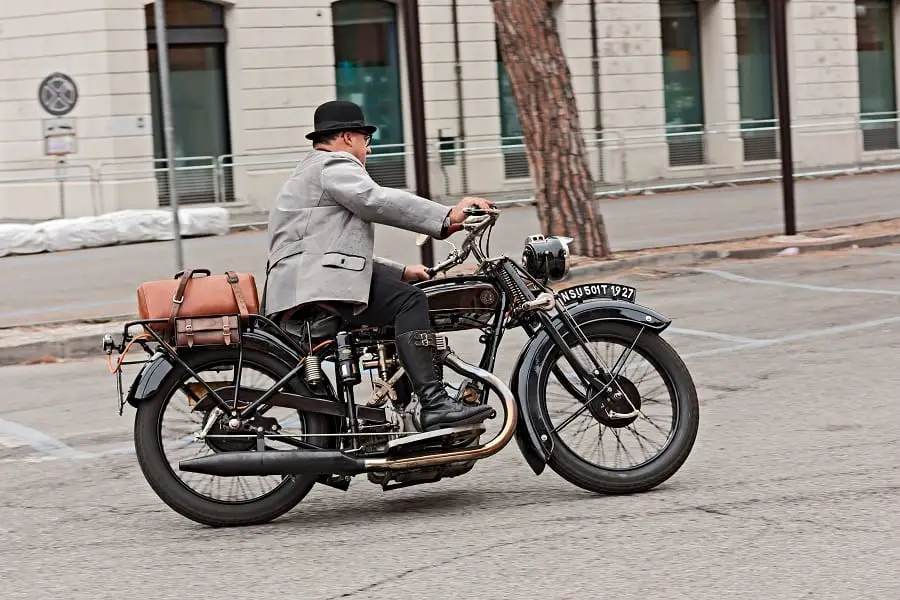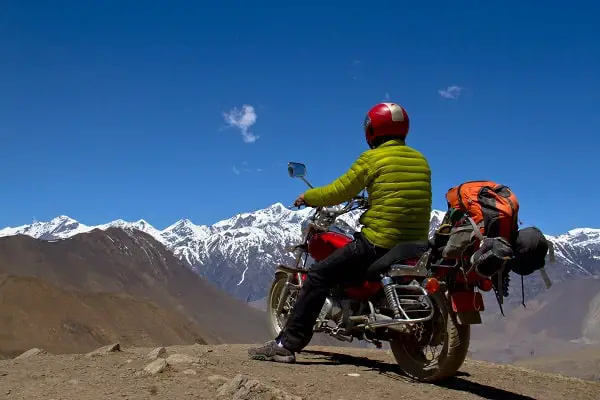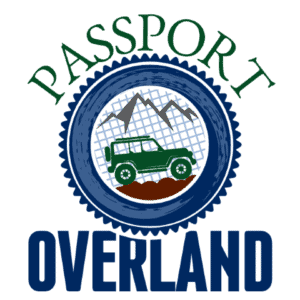
When riding an adventure motorcycle, your body is always exposed to the environment. There is always a possibility that you may fall or be hit by a rock. But how have you ever thought about your dressing code when taking this adventure?
Having the right riding gear is essential for your safety and comfort; from riding in boiling desert and freezing mountains, there is no compromise for your riding kits. Luckily, in the last few years, life has changed. Clothing technology and motorcycle manufacturing have greatly improved.
Today there are hundreds of shops with different riding gears to choose. This wide variety makes it hard to know what you need and what you don’t. This guide will help you with tips on how you should dress for an adventure motorcycle trip.
Clothing Fit Is Essential
The fitting of your riding gear is very crucial. Your leg length and sleeves should be enjoyable when walking but should be strictly long enough to be in line when riding or sitting. It should be baggy enough to enable extra layering and free movement but not too baggy to move up and down.
The fitment rule applies to all layers of the cloth, whether the base or the out layer of your clothes.
Dress In Layers

It would be best if you never underestimate the seriousness of layers beneath your kits. Over the years, bike riding materials have developed and varied from one material to another. Most adventure riders tend to mix the traditional and off-road riding kits when riding.
You should wear different layers to accomplish unique roles. The layers enable you to take away or add the temperature depending on the riding conditions or weather. The common layering should have a base, mid, and outer layer.
Closer to the skin is where base layers are worn. They are mainly stretchy and vary in thickness. The season in the year or climate should determine whether the base layer should be thin, medium, or ticker. The recommended base layer should be able to absorb sweat from your body.
The mid layer keeps you warm. Many kits perform this job, and also most riding jackets have quilted removable layers to keep you warm. The mid-layer clothes prevent wind penetration.
The outer layer is very critical in every adventure bike rider. They must be wind and waterproof, have some pockets, and definitely need some armor and wear resistance. Nowadays, the most common riding kit is the textile made since they are lighter and have another layering option.
Proper Ventilation
You should wear jackets and trousers that provide an outlet for gas, air, and liquid when riding in a hot environment. These garments offer you protection and allow the air to cool off the body. The best kit should allow free movement of air inside the garments and have rubber coated zips that seal when done. The front zip in the riding kit is the best vent.
Search Out for Additional Features
A good coat with a few simple additions can turn out to be an effective riding kit or cuffs adjustable over or under different gloves. Trousers, helmets, boots, undergarments, and gloves may help other functions.
Heated clothing is also another addition that you may carry. The attires are mainly woven in base, mid, or outer layer.
Essential Apparel for an Adventure Motorcycle Trip
The following are the essential motorcycle checklist:
- Jacket
- Helmet
- Boots
- Gloves
- Pants
- Eye Protection
- Repair Kit
- GPS
- Protective Padding
- Duffel Bag
- First Aid Kit
- Neck Buffs
Let’s take a closer look at each item…get into the specifics.
1. The Jacket
Not only does it provide safety to the rider, but the jacket also makes you look awesome. It would help if you had a jacket with good materials to protect you when an accident happens. The recommended jacket should have a thickness of 1.44mm heavyweight or 1mm lightweight. This level of thickness will stand wearing better in case of danger hence protecting you.
The back of the jacket should be long enough in a way that when you sit on the bike, it does not ride up. The jacket should also be visible, and it should have reflective materials for the visibility of other drivers.
Finally, the jacket should have forearms, spines, shoulders, elbows, and back protection. The jacket should be made of Carbon Fiber or Kevlar to withstand an accident.
2. The Helmet
If you have no intention of crashing your head against the pavement, then you must have your helmet on. A good helmet will shield you from wind, sun, little stones, debris, and bugs.
There are various helmets models; full face, dual-sport, open face, and half shell. Check them out on Amazon. All these helmets have the intended purpose; you should not carry an open-face helmet for an adventure trip. Adventure helmets have more ventilation a wide visor opening with removable peaks.
Flip front helmets are the recommended adventure helmets since they are easy to close and open, comfortable, and have a high protective rating.
3. The Boots
The following are tips for good adventure boots (check these Harley Davidson Boots here);
- Ankle support. The boot should have ankle support on both the outside and inside of the boot to protect your ankle.
- Waterproof. Nobody wants to have wet boots that have a bad smell. Your boots should be resistant to water and have waterproof socks. However, the boot’s choices should depend on where you are going; boots with no ventilation will sweat inside. You can try waterproof boots with ventilation.
- Shin Protection – Adventure boots should have good shin protection to protect your legs from being hit while off-roading.
- Comfort. Your riding boots should fit well to offer you the desired comfort. They should have soles that hold the foot pegs easily and have low heels.
4. The Gloves
The gloves are essential for your wrist protection. The weather condition is a factor you should consider when selecting your gloves. To protect you from cold during winter, the gloves should have good insulation. On the other hand, the summer gloves should be light enough to offer comfort to the ruder.
There are now gloves that can work with all touch screens with the technology. The gloves should be long enough to have palm pads and knuckle protection, you can check them out on Amazon.com.
5. The Pants
Just like the jacket, your pants will offer you protection and give you an awesome look. The most appropriate pants for males and females are Kevlar or leather trousers. The pants should have knees and hips protective gears.
6. The Eye Protection

The eyeglasses are only applicable when you have an open face, half-shelf helmet, or skullcap since the rest have eye protection incorporated in them. Your adventure glasses should have proper UV protection and resistant materials.
7. Repair Kit
For your motorcycle adventure trip, a tire repair kit is inevitable in case of an emergency. The kits will have all the necessary equipment you need to repair a flat tire and other minor problems. Today, there is a universal repair kit that works with any model or makes of motorcycle.
A normal tool kit should have screwdrivers, wrenches, and socket set items. You can add a few things like duct tape, a flashlight, and zip ties.
8. GPS
With a trusted GPS, you are guaranteed to enjoy your cross-country adventures with your motorbike. The GPS ensures you are not lost in the jungle, and you have ample time to explore. GPS is light and attaches to your bike easily.
It would be best if you always looked for a GPS that is readable in the sunlight and one that is glove-friendly. Pairing your GPS with your smartphone is an added advantage since you will be alerted to upcoming hilly or curvy roads.
9. Protective Padding
Apart from the pants and the jacket, the protective padding should be on your travel list. The elbow pads and sturdy knees ensure your protection when an accident happens. They should be lightweight and breathable in a way that you don’t even recognize you are wearing them. They should have adjustable straps to loosen and tighten your pads to your desired comfort. Check out latest pricing on Amazon.
10. Duffel Bag
A heavy-duty bag should be on your checklist for your upcoming motorcycle adventure trip. The bag should be water-resistant to protect your stuff in case of rain. The bag has numerous pockets that are easily accessible and easy to hook on your motorcycle. It is spacious and can fit everything you need on your adventure trip. Check on amazon.com.
11. First Aid Kit
Most people ignore it, but a first aid kit should be a no-brainer. With adventure, accidents can happen anytime, and you or your pillion can get hurt. A well-stocked first-aid kit is crucial in case of serious injuries, and it can be the difference between life and death before you find a medical facility.
12. Neck Gaiters or Buffs
You should leave for adventure without neck gaiters. They protect your chest and neck from wind during winter and shield your neck from sunburn during summer. If you’re camping, the neck gaiters act as sleeping caps during those cold nights. Find really cool designs on Amazon.
Final Thoughts
That’s how you should dress for an adventure motorcycle trip. The attires and equipment are favorable for both male and female riders. Some of the items on the list may be expensive, but your safety is worth every penny.

